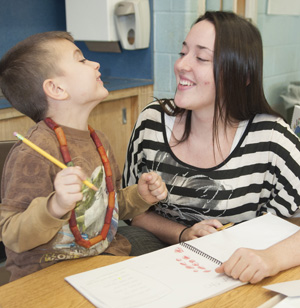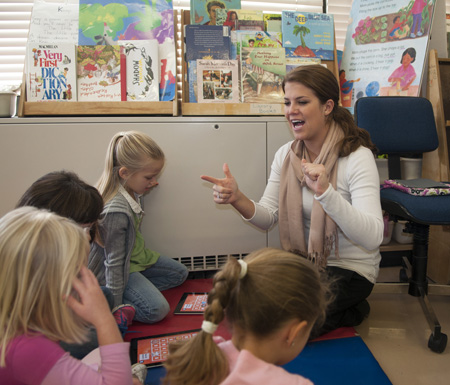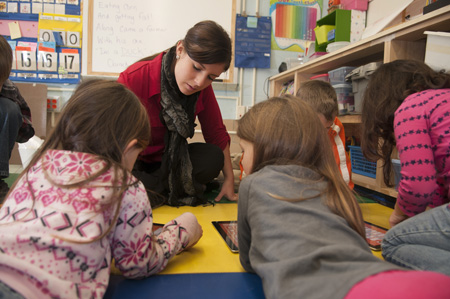
12/04/2012
You can’t learn how to swim by dipping your toes in the water. The same idea holds true for teaching.
Recently however, SUNY Cortland juniors Ashley Whitney and Kelly Rambo — both aspiring elementary education teachers — had an opportunity to dive headfirst into the deep end of their chosen profession during a unique, two-week immersion in a Groton (N.Y.) Elementary School classroom.
“We got to see the different personalities of the students as they go through the day,” said Whitney, a childhood education major from Rochester, N.Y. “We also saw each aspect of being a teacher and what they go through on a daily basis.”
A new partnership between the College and Groton School District involves two weeks of hands-on classroom experience in which aspiring educators forego their regular, on-campus classes and follow the course of the entire Groton school day. The education students are there from the time the children arrive until they depart and are involved in every other aspect of a first- through sixth-grader’s busy school day.
 |
| Kelly Rambo, a junior childhood education major from Riverhead, N.Y., worked with first graders on a Bingo game dealing with spelling. |
Whitney, Rambo and the 13 other SUNY Cortland students involved in the pilot program didn’t lead the classes, but they helped the Groton teachers with classroom activities such as using iPads and reading with children while they observed the rhythms of a real classroom.
“It’s not until you’re in the classroom that you learn how to teach,” said Rambo, a childhood education major from Riverhead, N.Y. This was her first field classroom experience at college. “It’s the interactions between you and the children that show you the best possible ways to reach the desired outcomes as a teacher.”
The field experience took place from Nov. 2 through 16 and both College faculty and elementary school teachers pronounced it a success.
“The students really feel like they’re welcomed in the school, like they are a partner in the school,” said Beth Klein, a professor and interim chair of SUNY Cortland’s Childhood/Early Childhood Education Department.
“On the other side, they’re exhausted. They are not used to being in a school setting all day long and then having to go home and do their work. So they’re getting a taste of real life. That’s been good for them as well.”
For most of the education students, the foray to the rural school district was an early hands-on experience occurring well before their senior year, when they are required to spend a semester student teaching. For some, it’s an opportunity to either validate, or re-evaluate, their career choice.
“It’s really exhausting being a teacher,” Rambo said. “There was one student who just did not want to do his work. He complained about math. But the iPads clicked with him and he did not want to give it back to me. He absolutely loved it. The iPads introduced math in a new way to him. So the next day, when I saw him working on his worksheet, he did not hesitate because he realized he knew math and enjoyed it.”
“This little girl was working on addition using a number line and she really didn’t get it,” Whitney recalled. “So I sat down with her one-on-one and physically moved her hand and helped her. Within a few minutes of doing that, she really got it. This moment was really inspiring to me, because this is the feeling that teachers get that’s so rewarding to them and makes it all worth it in the end.”
The program is part of SUNY Cortland’s ongoing effort to become more of a true partner with surrounding school districts; focusing on ways they can work together to improve both teacher education and the education children receive in the classroom.
Groton teachers and administrators have been very open to the idea, Klein said. That’s partly because many of them have been in the SUNY Cortland students’ shoes.
“This way (the practicum students) get to see the flow of the entire day,” said SUNY Cortland graduate Keith Goodwin ’92, M.S.Ed. ’99, a fifth grade teacher at Groton Elementary School. “Which I think is a huge benefit for them. They get to think about if this were their classroom, what would they change, what would they leave the same? So I think as they approach student teaching this is going to pay huge dividends for them.”
Renee Schram Potter ’91, M.S.Ed. ’97, teaches the junior-level course to which the field experience is tied, coordinates student teaching for childhood/early childhood education majors and serves as the point person for this project.
“When our students are only going in there once a week for a few hours, and going into different schools over the whole semester, they’re missing a huge component of the children’s education, which is the connection,” Potter explained.
Immersing the junior-level college students in a full-day field experience is a break with tradition for SUNY Cortland’s Childhood/Early Childhood Education Department, Klein noted.
“Normally, the students find hours around their classes and go into the schools for a couple of hours,” Klein said. “That scattershot approach doesn’t provide them with a very good picture of what happens in a classroom all day long and from day to day. So we wanted to see if there was some way we could arrange to do that. And the Groton District opened its doors to us.
“Groton is the first school where we’re doing this kind of project,” Klein said. “We do have other districts where we’re doing other kinds of partnerships.”
 |
| Ashley Whitney, a junior childhood education major from Rochester, N.Y., worked with first graders on a Bingo game dealing with spelling. |
To redesign this aspect of the College’s education program, Cortland faculty and Groton school staff met over the spring and summer to plan the practicum experience. Although all Childhood Block I students have been required to spend 50 hours in an elementary classroom, they had to work around their own class schedule to fit in the Childhood Block I practicum. This fall, College School of Education administrators tweaked the junior year curriculum to free up two weeks from classroom attendance so students could have an uninterrupted experience.
Ultimately SUNY Cortland is moving toward a “co-teaching” model in its approach to practicum and student teacher experiences, rather than the traditional approach of having the student teacher gradually take over teaching the class, Klein noted.
But for now, its teacher candidates in the schools provide another set of willing hands.
“It’s nice for my students to have an extra person to ask questions of or to read with them one on one, which the practicum student does quite frequently in my room,” said Goodwin. “So it’s beneficial for them as well.”
Meeting Groton Elementary School Principal Timothy Heller for a two-hour school and community orientation was a valuable experience for the college students.
“When the principal spoke with them, within the first 15 minutes you could just see huge smiles on the students’ faces,” Potter said. “Generally when you ask a practicum student how much time they spent with a principal, they will say it’s only about five minutes. Heller toured them through the building, he told them about the population of the school and the needs of the children, and what was each person’s responsibility. Then we took a bus tour of the community showing where the students were coming from.”
The novel practicum format at times placed SUNY Cortland faculty who teach elementary-level specialties such as science, mathematics or technology inside the elementary school, observing, advising and critiquing the students enrolled in their concentration.
 |
|
Liz Lenzi, a senior childhood education major from Saratoga, N.Y., worked with first graders Alyssa Slater and Dakodah Mayhew. In the top left image, she celebrated a successful spelling while working with first grader Dorian Young. |
“I think the other really great thing for the classroom and the teachers is that the faculty listened to what the teachers have said and really started thinking about the relevance of our class assignments,” Potter said. “Not only how the assignments will help our students become better teachers but how they will impact the children in the classrooms at Groton.”
The Groton teachers were especially pleased to have 15 volunteers in their classrooms showing the children how to use digital communication equipment such as iPads.
“What’s happening is that our students have been bringing technology into the classroom,” said Potter.
The model will continue to be refined.
“Renee will offer a workshop for the Groton teachers on how to work with students as co-teachers,” Klein noted. “It may include some of these same students. Some of the teachers have asked if they could have the students as co-teachers because they have developed such a good relationship with them.”
The College also will take a look at ways to expand on the model with its Childhood Block II curriculum, which currently looks the way ChildhoodBlock I did before this year.
Goodwin, the Groton Elementary teacher, supports this evolution, which should help future educators succeed in a regulatory environment that seeks to foster early real-life learning opportunities.
“There are changes being made at the state level to the teacher certification requirement so anything we can do to give these young professionals a leg up in their job is going to help tremendously,” Goodwin said.
Rambo, the SUNY Cortland junior, agreed.
“Some people go into this experience and realize they don’t want to be a teacher anymore, but it showed me that this is what I want to do,” Rambo said.